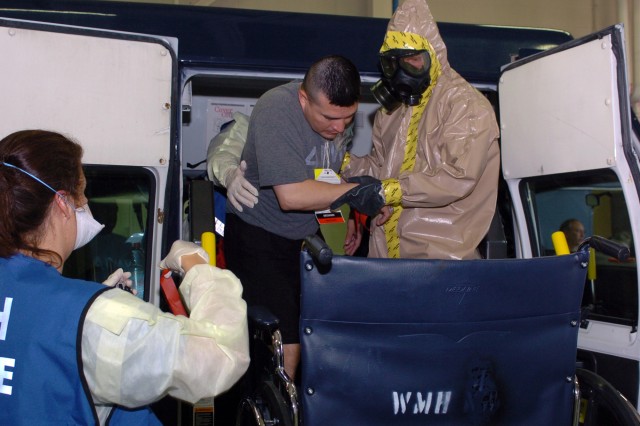
FORT McCOY, Wis. (Army News Service, July 2, 2009) - In the largest training exercise of its type, more than 2,300 Army Reserve Soldiers helped civilian authorities respond to chemical, biological, radiological and nuclear attacks in June.
Federal, state and local officials joined military personnel in "Red Dragon," a simulation filled with life-threatening scenarios spread across southern Wisconsin.
At various points, the exercise involved more than a dozen hospitals and hundreds of civilian participants - along with hundreds of simulated casualties.
Most of the Soldiers taking part belong to chemical units, which specialize in such skills as decontamination and protection from weapons of mass destruction and hazardous materials detection. The exercise allowed them to place their skills into action on a large stage.
Brig. Gen. James T. Cook, who commands the 415th Chemical Brigade from Greenville, S.C., said in an interview June 16 this marks a large step up in operations, comparing it to a "crawl-walk-run" process. "This year, it's a sprint," he said.
In previous years, the exercise was held almost exclusively at Fort McCoy, Wis.
The base still served as the center of operations, with units both training here and travelling to cities as far away as Milwaukee.
The Fort McCoy Fire Department, along with numerous other public safety departments, also participated.
Cook, whose unit oversaw the two-week exercise, said one of the key goals is to better assist - and integrate with - local emergency responders if the Army is called in to help.
"If something ever happens on our homeland, we are trained ... to deploy a unit to help the civil authorities and the National Guard of that state in event of a chemical, biological, radiological or nuclear event," he said.
There were a variety of worst-case simulated events conducted, including the imagined detonation of a radioactive explosive at a crowded Milwaukee baseball stadium.
Soldiers and civilians worked together to protect and aid the public throughout the scenarios.
In many cases, Soldiers acted the part of victims to help hospitals practice dealing with the large volumes of injured patients.
The exercise was part of the planned homeland security response to catastrophes, whether natural or man-made, said Col. James Murphy, the operation's lead planner and commander of the 457th Chemical Battalion from Greenville, S.C.
"Red Dragon is becoming one of the most important exercises in the Department of Defense," he said in a June 13 interview. "We face numerous threats. Those threats are proliferating."
Murphy, who has worked in civilian emergency services for more than two decades, said the exercise will help the response speed of the units and also will help the participating hospitals meet their own certification requirements.
A variety of agencies participated in Red Dragon, including the FBI, the Federal Emergency Management Agency, the U.S. Department of Health and Human Services, local police and fire departments, local hospitals, local governments, the Defense Threat Reduction Agency and the U.S. Coast Guard.
The Reserve units spent a week of the exercise undergoing validation testing, with Army officials monitoring their mastery of the needed skills.
Cook pointed out Citizen-Soldiers conduct their military duties in addition to maintaining their civilian careers. He expressed his appreciation for the families of those Soldiers who make it possible for them to serve.
"I want to thank the families for sacrificing their time and allowing them to do this profession," he said.
Cook spoke June 15 to assemblies of the participating troops about the importance of their mission and the skills they bring to the effort. He noted chemical units were not the only Soldiers who participated in Red Dragon.
"They come from several different disciplines," he said.
Medical units, logistics, support, military police, chaplains and even Army fire-fighters are taking part, he said. National Guard units will be working with Reserve Soldiers without regard to different service divisions, Cook said.
Cook said Red Dragon gives troops the practice that allows them to conduct their work as second nature and provides them a better communications framework with civilians during a crisis.
"We're able to speak the same language to help them out," he said.
(Staff Sgt. Gary A. Witte is with the 300th Mobile Public Affairs Detachment and writes for The Real McCoy newspaper.)

Social Sharing